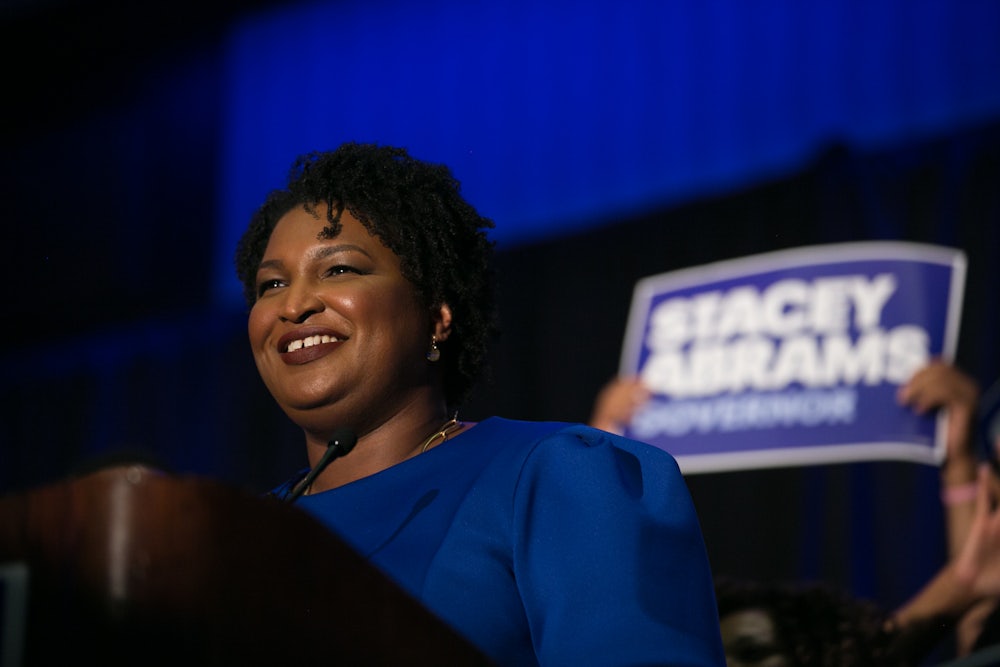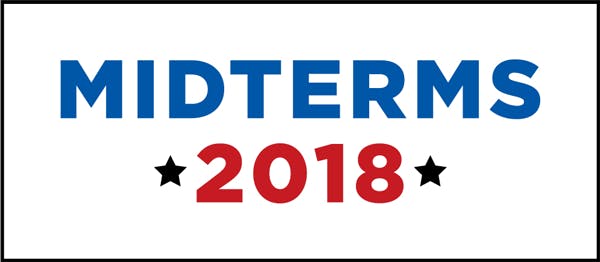For the first time in American history, white men comprise a minority of Democratic candidates for the U.S. House of Representatives: The party has nominated 180 women and 133 people of color for the House’s 435 seats, according to Politico. “The numbers are even starker in the districts without Democratic incumbents,” Elena Schneider reported. “In the 125 districts where a Democratic incumbent is leaving office or a Republican seat is at risk of flipping...more than half the nominees (65) are women.” White male dominance in the House—and Senate—won’t end in November, but it appears to be on the wane.
This “year of the woman” isn’t limited to Congress. A record 14 women are competing in the 36 gubernatorial races being decided in November. Eleven of them are Democrats, and three of those would make history if they won their races, as Vox noted earlier this week: Georgia’s Stacey Abrams would become America’s first black woman governor; Vermont’s Christine Hallquist would become the first transgender governor; and Idaho’s Paulette Jordan would become the first Native American governor. In South Dakota, Republican Kristi Noem is likely to win her bid to become the state’s first female governor.
The latest evidence suggests that these candidates are up against greater odds than their counterparts running for Congress. As of Thursday, according to Politico’s women candidate tracker, half of all women running for the House and 42 percent of women running for Senate have won their primaries. But only 27 percent of women candidates for governor have accomplished the same. Some of that may have to do with greater competition for fewer seats: 61 women had declared campaigns for just 36 gubernatorial seats. But historical evidence bears out this truth: It’s extremely difficult for women to become governor.
There are only six female governors in office today, down from a peak of nine in 1994. There have been only 39 women governors in U.S. history, and 22 states have never had one at all, according to Rutgers University’s Center for American Women in Politics (CAWP). Voters didn’t elect a female governor in her own right until 1974, when Connecticut voters put Democrat Ella T. Grasso in office. Previously, three female governors had succeeded their husbands in office.
Jane Swift, a Republican and former acting governor of Massachusetts, explained what women are up against in running for the office. “If they think you’re nice, they think you can’t run their state, and if they think you can run their state, they worry you’re not nice,” she told The New York Times. The role of governor includes a ceremonial aspect, not unlike the role of president; the governor moves their family into a mansion, where they remain in the public eye for at least the next four years. If the governor is male, traditional notions about breadwinning husbands persist without challenge. A female governor, however, subverts those old ideas.
“The biggest challenge that women face when running for executive office is they really have to work twice as hard to prove that they’re qualified, because we know that voters are more accustomed to seeing women as part of a deliberative body like a legislature,” said Amanda Hunter, the communications director for the Barbara Lee Family Foundation, which has tracked every gubernatorial race with a female candidate since 1998.
“I think women, when they run to be the chief executive, still have a challenge, which is the stereotype about women not being tough enough, or strong enough, to be that final authority and to be the place where the buck stops,” said Debbie Walsh, CAWP’s director. (CAWP and the Barbara Lee Family Foundation run Genderwatch 2018, which monitors the campaigns of female candidates and analyzes gender’s influence on electoral outcomes.)
If a woman can break the gubernatorial glass ceiling, however, she might help smooth the way for future candidates. “For example, Molly Kelly won her primary in New Hampshire. And New Hampshire’s had two female governors, Governor Shaheen and Governor Hassan,” Hunter said. “And we’ve seen that trend with Arizona. They’ve had four women governors. Kansas has had two. Then of course Gretchen Whitmer won the primary in Michigan, and they had a female governor not terribly long time ago.”
Where men can rely on their credentials, women are more likely to win over voters by emphasizing personal experience and real-world achievements, either in state or local politics or in the business world, according to Hunter. The Barbara Lee Family Foundation’s research found that successful women candidates find ways to balance authenticity with likeability, but even if they do discover that balance, they can still face other institutional obstacles. “Although women now often regularly raise and spend money in their campaigns on par with their male opponents, women candidates still report being excluded from financial circles that include the wealthiest and best-connected donors,” the foundation concluded.
With so few female governors in office, and so many obstacles to increasing their numbers, any uptick seems welcome. But a victory for a woman candidate isn’t always a victory for the women she represents. Four of the nation’s six female governors are Republican, and are hostile to legal abortion and to LGBT rights. In 2017, Alabama’s Kay Ivey, who is up for reelection, signed a law allowing adoption agencies to refuse to place children with same sex couples. Iowa’s Kim Reynolds, who is also up for reelection, signed a May law banning abortions after a fetal heartbeat is detected. In New Mexico, Governor Susana Martinez opposed same-sex marriage prior to the Supreme Court’s 2015 ruling in Obergefell v. Hodges, which legalized the practice, and has stated opposition to abortion rights (though some anti-abortion activists believe she hasn’t expressed enough public support for restrictive abortion regulations).
South Dakota’s Kristi Noem and Hawaii’s Andria Tupola, the two Republican nominees seeking a first term, also oppose abortion rights. Tupola has even re-posted articles by Operation Rescue, an extremist anti-abortion group, on her official Facebook page, and Noem has repeatedly attacked abortion rights as a member of Congress. As The Honolulu Star-Advertiser reported in 2014, Tupola also helped lead protests against the governor’s call for a 2013 special legislative session to legalize same-sex marriage.
Walsh called 2018 “a bit of a breakthrough moment” for women running for governor, and that’s clearly true in general. There’s a record number of candidates, and Abrams, Jordan, and Hallquist could all make history—not just for the Democratic Party, but for the country. But it’s not as clear, in a case like Noem’s, that a breakthrough moment for female candidates would mean a breakthrough moment for all women. Would her victory help accustom South Dakota voters to the idea of a woman as the state’s chief executive? Or will she end up pushing policies that make it more difficult for other women to achieve what she has done? In some cases, an achievement for one woman creates quandaries for others.

